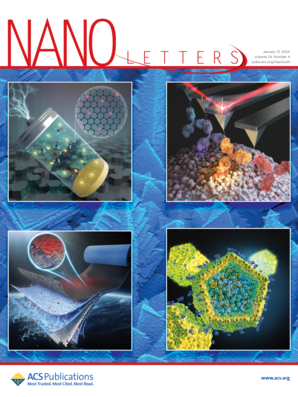Specific Cell Adhesion at Nano-Biointerfaces: Synergistic Effect of Topographical Matching and Molecular Recognition
IF 9.6
1区 材料科学
Q1 CHEMISTRY, MULTIDISCIPLINARY
引用次数: 0
Abstract
Specific cell adhesion is essential for functional biointerfaces, especially in cancer diagnosis. However, the role of surface nanotopography in this process remains unclear. Herein, we reveal the critical role of surface nanotopography by measuring adhesion forces utilizing fluidic force microscopy (FluidFM). The antibody-coated nanospiky surface exhibits cell adhesion force 1 to 2 orders of magnitude higher than those of the flat, nanospiky, and antibody-coated flat surfaces. This amplified effect is related to a time-dependent reversal, with adhesion force on nanospiky surfaces initially weaker than that on flat surfaces but eventually surpassing it. Mathematical simulations further demonstrate that micro-nanostructured surfaces maximize contact points, enabling multiscale, multipoint cell–substrate interactions, consistent with experimental results. From thermodynamic and kinetic perspectives, we propose a multiscale, multipoint recognition model based on the synergistic effect of topographical matching and molecular recognition. Our findings provide valuable clues for biointerface design in cancer diagnosis, drug screening, and tissue engineering.

纳米生物界面上的细胞特异性粘附:地形匹配和分子识别的协同效应
特异性细胞粘附是功能性生物界面的必要条件,特别是在癌症诊断中。然而,表面纳米形貌在这一过程中的作用尚不清楚。在这里,我们通过使用流体力显微镜(FluidFM)测量粘附力来揭示表面纳米形貌的关键作用。抗体包被纳米尖刺表面的细胞粘附力比平面表面、纳米尖刺表面和抗体包被平面表面的细胞粘附力高1 ~ 2个数量级。这种放大效应与时间相关的反转有关,纳米刺状表面上的附着力最初比平面表面弱,但最终会超过它。数学模拟进一步表明,微纳米结构表面最大限度地增加了接触点,实现了多尺度、多点的细胞-衬底相互作用,与实验结果一致。从热力学和动力学的角度出发,提出了一种基于地形匹配和分子识别协同效应的多尺度、多点识别模型。我们的发现为癌症诊断、药物筛选和组织工程中的生物界面设计提供了有价值的线索。
本文章由计算机程序翻译,如有差异,请以英文原文为准。
求助全文
约1分钟内获得全文
求助全文
来源期刊

Nano Letters
工程技术-材料科学:综合
CiteScore
16.80
自引率
2.80%
发文量
1182
审稿时长
1.4 months
期刊介绍:
Nano Letters serves as a dynamic platform for promptly disseminating original results in fundamental, applied, and emerging research across all facets of nanoscience and nanotechnology. A pivotal criterion for inclusion within Nano Letters is the convergence of at least two different areas or disciplines, ensuring a rich interdisciplinary scope. The journal is dedicated to fostering exploration in diverse areas, including:
- Experimental and theoretical findings on physical, chemical, and biological phenomena at the nanoscale
- Synthesis, characterization, and processing of organic, inorganic, polymer, and hybrid nanomaterials through physical, chemical, and biological methodologies
- Modeling and simulation of synthetic, assembly, and interaction processes
- Realization of integrated nanostructures and nano-engineered devices exhibiting advanced performance
- Applications of nanoscale materials in living and environmental systems
Nano Letters is committed to advancing and showcasing groundbreaking research that intersects various domains, fostering innovation and collaboration in the ever-evolving field of nanoscience and nanotechnology.
 求助内容:
求助内容: 应助结果提醒方式:
应助结果提醒方式:


